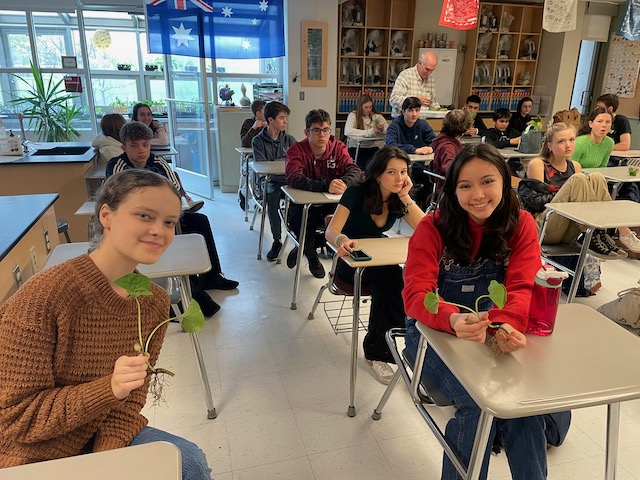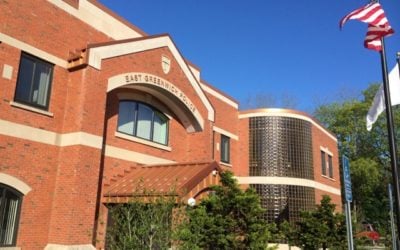Above: EGHS science students with the wild ginger they’ve potted up. Photos by Nicholas Rath
By George D. Christie
It has been a while since I was in a high school classroom, so I admit I was a bit nervous a couple of weeks ago walking into Mrs. Ayala’s senior elective class in botany to give a guest lecture on how to read labels on plants while shopping at a garden center, review student designs for the school’s central courtyard and pot up some rooted cuttings of a favorite native ground cover of mine, Asarum canadense or wild ginger. I shouldn’t have been. Despite nearly the end of their high school years (congratulations to all!) and being bogged down with AP testing and everything else that goes with finishing up high school, they were an attentive group. The difference between a plant raised from open-pollinated seed and one created as a tissue-cultured clone is not as exciting as graduation parties, but they were quick with their comments and questions, pleased to display their courtyard designs (can anyone say koi pond!?) and happy to pot up the ginger cuttings.
This botany elective is the brainchild of E.G. Science Department head Nicholas Rath, and explores a wide range of botanically related subjects, from greenhouse propagation to conservation and identification to medicinal uses of plants. This wide range of ways of looking at plant life means there is a bit of something in it for every student. Hands-on work with seeds and plants, theoretical work with garden design and function and a diversity of other botanical concepts keeps the class lively. My potpourri of topics turned out to be just the right mix, from consumer education to planting techniques with a loop through some basic design principles.
The second class, a mix of students from freshman to seniors, was a couple of days later and they benefited from some editing of content between classes, no lesson plan ever survives first contact with actual students! We started with their courtyard designs which gave us more time to discuss concepts like differences in shade based on building orientation, the need for water, and the insurance questions raised by massive grills and fire pits. Their logic was impeccable; however, you can’t have good class parties with family-sized grills or fires. One thing I noticed right away was most of their designs included lots of seating – from big tables to quieter spaces for “groups” of two. Based on their emphasis, I would guess many high school students use their free time to socialize with each other. Who knew?
I also pointed out the universal design principle that stairs, whenever possible, should be minimized, as they automatically exclude many people with mobility issues. Sure, ramps and sloped walkways take up more room, but what good is spacious high ground to which some are excluded? As is pretty typical, by the time I was done with the second class, the nerves were long-gone and I was thinking of new classes I might be able to help with next year.
In closing, if several weeks from now, your student brings home a rooted cutting of ginger, it is wild ginger, native to North America, and not the edible ginger from the Orient. It should be planted in dappled to deep shade and kept watered. It will spread slowly by short runners. The small cutting they planted last week will grow to between six and eight leaves next year and 10+ the year after, making an attractive clump of foliage. They are deciduous, so die back to the ground in the fall. If you aren’t sure you’ll remember where you planted it, my tip is to use brightly colored plastic golf tees—leave about half-an-inch exposed. Those little markers have saved more than one of my plants, I can tell you.
Now, Mr. Rath, about next year. Don’t you think winter sowing of native seed would be a good idea?
Formally trained in entomology and landscape architecture, George Christie has worked in mosquito control, environmental education and garden design and plant sales. He currently works for the Rhode Island Natural History Survey managing their rare species database.






 Subscribe
Subscribe